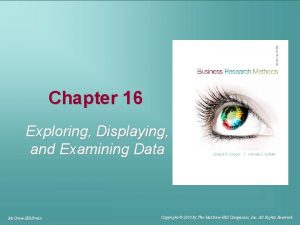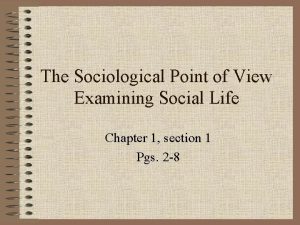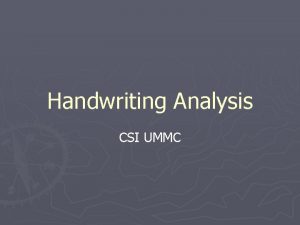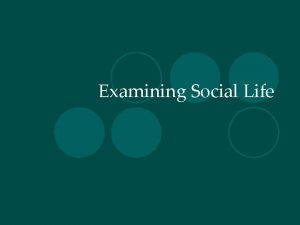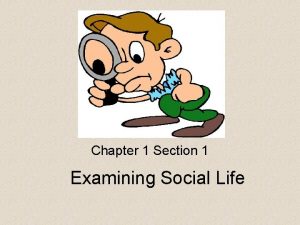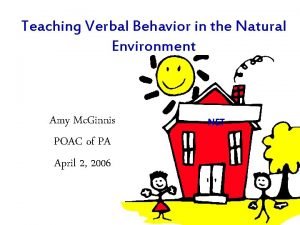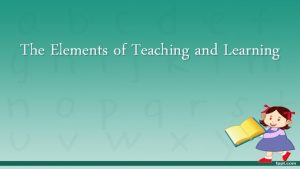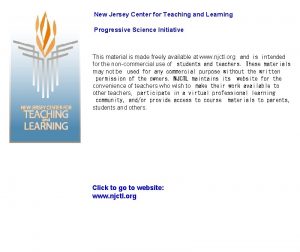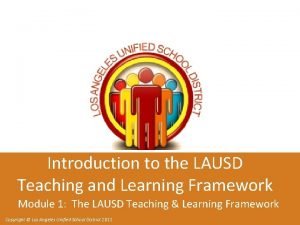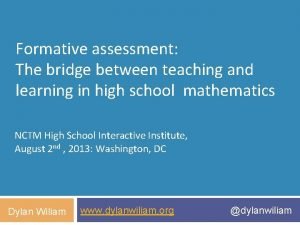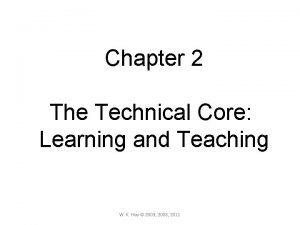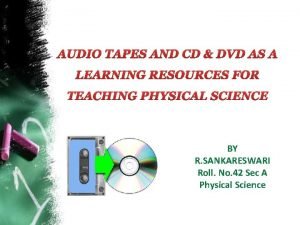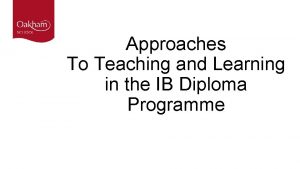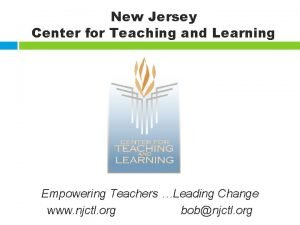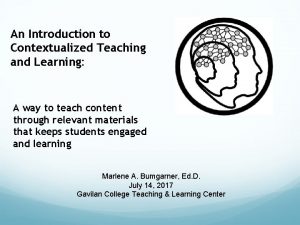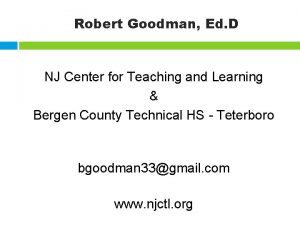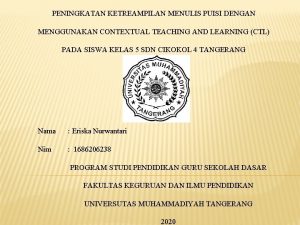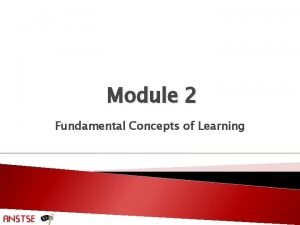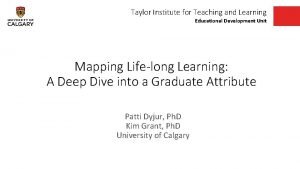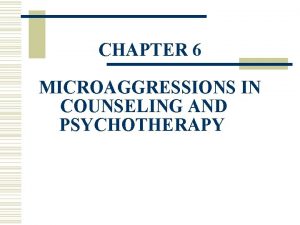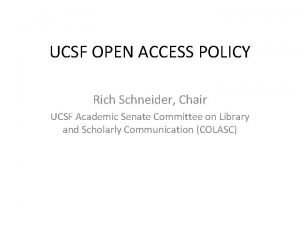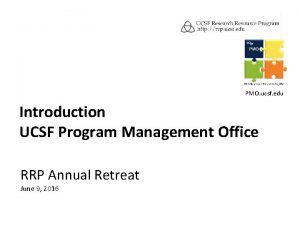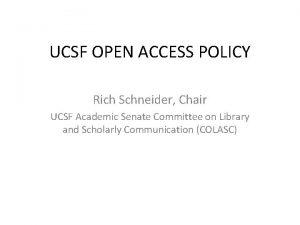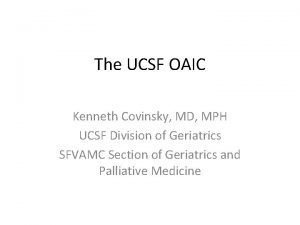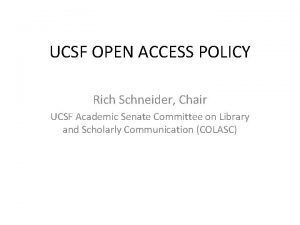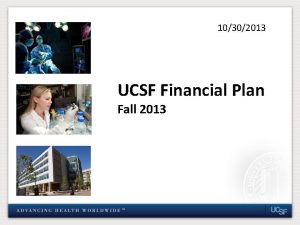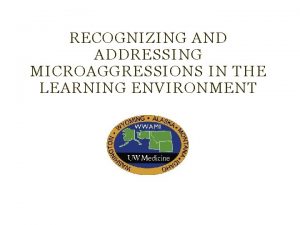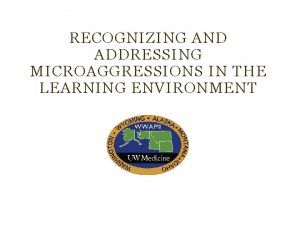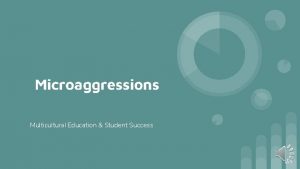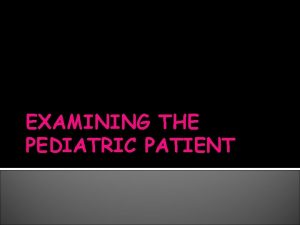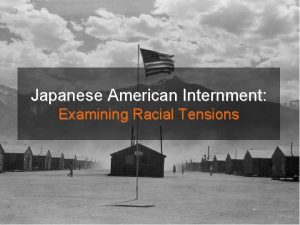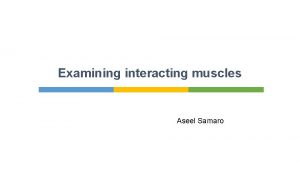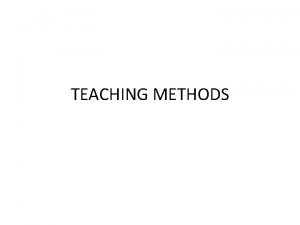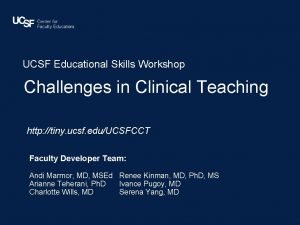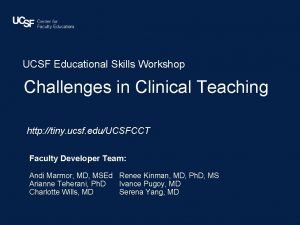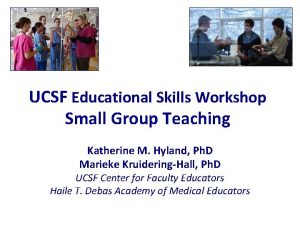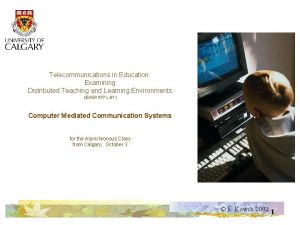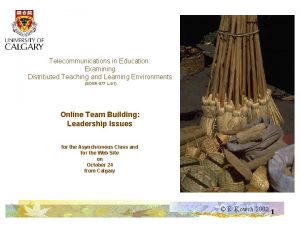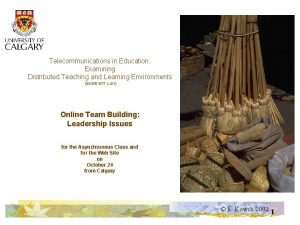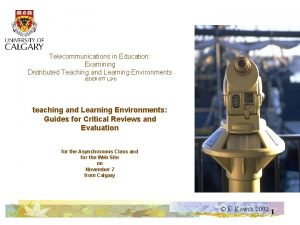MICROAGGRESSIONS Examining the Teaching and Learning Environment UCSF









































- Slides: 41

MICROAGGRESSIONS Examining the Teaching and Learning Environment UCSF Educational Skills Workshop Robin Goldman, MD, MPH Sneha Daya, MD January 30, 2020

Introduction Workshop Faculty Robin Goldman, MD, MPH Assistant Professor Internal Medicine Pediatrics Sneha Daya, MD Assistant Professor Internal Medicine Pediatrics 2

Online Workshop Resources http: //tiny. ucsf. edu/TEI 3 3

Learn more and register https: //wiki. library. ucsf. edu/display/UCPLS/ Teaching+for+Equity+and+Inclusion

Creative Commons License Attribution-Non. Commercial-Share Alike 3. 0 Unported You are free: • to Share — to copy, distribute and transmit the work • to Remix — to adapt the work Under the following conditions: • Attribution. You must give the original authors credit (but not in any way that suggests that they endorse you or your use of the work). • Noncommercial. You may not use this work for commercial purposes. • Share Alike. If you alter, transform, or build upon this work, you may distribute the resulting work only under a license identical to this one. • See http: //creativecommons. org/licenses/by-nc-sa/3. 0/ for full license. 5

Group Ground Rules • • • Respect Confidentiality Accountability Assume positive intent Recognize that intent and impact may be different Find your STRETCH ZONE! Use “I” statements Ask questions People will make mistakes- this does not make you “bad, ” we are here to be open and learn 6

Learning objectives • Identify multiple levels of bias and microaggressions in the learning, work and clinical environments • Acknowledge, analyze, and critique power differentials in the learning, work and clinical environments • Employ allyship techniques to address bias and microaggressions in the learning environment and beyond (i. e. practice/rehearse for real life!) 7

Roadmap • Current Conditions • Definitions • Socioecological Model • Power Dynamics Exercise • Exploring Interpersonal Skills • Brainstorming about our Systems • Reflection 8

CURRENT CONDITIONS 9

WHY? Examining our current learning climate Ever Witnessed Discrimination All Residents (N=295) 83% Gender 76% Race or Ethnicity 68% 65% English Language Proficiency Academic Performance Age 60% 57% Immigration Status SES Schaeffer et al, 2017 10

WHY? Examining our current learning climate • Sources of discrimination Patient’s Family Medical Staff Co-Resident Attending Schaeffer et al, 2017 11

Faculty Climate Survey • Climate that was good or very good for women: 60% (2017) • Decreased from 68% in 2011 • Underrepresented in medicine facing unequal treatment: 33% (2017) • Non-underrepresented in medicine facing unequal treatment: 10% • Climate that was good or very good for LGBTQ persons: 71% • Unaware of treatment of people with visible or invisible disabilities • Over 1700 faculty/staff have completed the DEI Enact training • Goal: all UCSF schools to get trained 12

WHY? Examining our current learning climate • While 80% of our residents would choose to report discrimination against patients, only 37% would report discrimination against themselves WHAT DOES THIS TELL US? Schaeffer et al, 2017 13

DEFINITIONS 14

KEY TERMS • Unconscious bias • Privilege • Microaggression • Intersectionality • Allyship • In small groups, develop a definition for one of these terms. 15

DEFINITIONS • Unconscious bias- social stereotypes about certain groups of people that individuals form outside their own conscious awareness • Privilege- operates on personal, interpersonal, cultural, and institutional levels and gives advantages, favors, and benefits to members of dominant groups at the expense of members of non-dominant groups • Microaggression- brief and commonplace daily verbal, behavioral or environmental indignities (whether intentional or unintentional) that communicate hostile, derogatory, or negative slights and insults • Intersectionality- the interconnected nature of social categorizations such as race, class, and gender, regarded as creating overlapping and interdependent systems of discrimination or disadvantage • Allyship- a lifelong process of building relationships based on trust, consistency, and accountability with marginalized individuals and/or groups of people 16

SOCIOECOLOGICAL MODEL 17

The Social Ecological Model A Framework 18

POWER DYNAMICS EXERCISE 19

Intrapersonal: Power Mapping 20

DR: AT Yrs at hospital? Medical Hierarchy? Prior experiences? Difference of Priorities? Stereotype threat? Power Mapping: Making the Implicit Explicit ATTENDING PHYSICIAN RESIDENT MD DR: PT Title? Education Yrs Experience? Gender? Race/Religion? Stereotype threat? ICU High Acuity High Stress Multiple Tasks and Responsibilities PHYSICIAN’S ASSISTANT PATIENT 21 DR: PA Yrs Experience? Gender? Prior Experiences? Medical Hierarchy Yrs at the Hospital? Imposter syndrome? Stereotype threat? PA: PT Title? Education? Yrs Experience? Race? Gender? Imposter Syndrome? AT: PA Gender? Medical Hierarchy? Admin Hierarchy? Difference of Priorities? Prior Experiences? Stereotype threat? Imposter Syndrome?

RESIDENT MD DR: PT Title? Education Yrs Experience? Gender? Race/Religion? Stereotype threat? ICU High Acuity High Stress Multiple Tasks and Responsibilities DR: PA Yrs Experience? Gender? Prior Experiences? Medical Hierarchy Yrs at the Hospital? Imposter syndrome? Stereotype threat? PHYSICIAN’S ASSISTANT PATIENT PA: PT Title? Education? Yrs Experience? Race? Gender? Imposter Syndrome? 22

DR: AT Yrs at hospital? Medical Hierarchy? Prior experiences? Difference of Priorities? Stereotype threat? ATTENDING PHYSICIAN RESIDENT MD DR: PA Yrs Experience? Gender? Prior Experiences? Medical Hierarchy Yrs at the Hospital? Imposter syndrome? Stereotype threat? AT: PA Gender? Medical Hierarchy? Admin Hierarchy? Difference of Priorities? Prior Experiences? Stereotype threat? Imposter Syndrome? PHYSICIAN’S ASSISTANT 23

Personal Power Mapping Now you try! • Think about a situation where you witnessed a microaggression • Who were the others involved? • Make your own power map of the situation (5 mins) • Discuss with a partner how your personal power affected this situation (10 mins) • How did this exercise make you think differently about the perceived power of other people in this situation? • Large group reflections (5 mins) 24

INTERPERSONAL EXPERIENCES 25

Interpersonal: Before Setting the stage • Expectations • Naming • Frame “Calling in” versus “calling out” 26

Interpersonal: Case #1 Setting the stage • You are a small group facilitator. During a break, you over hear a conversation between students: • White student: Hey, how was your break? • Black student: Good, it was nice to see my extended family for Christmas. • White student: Oh… you don’t celebrate Kwanzaa? • Pair Share: What could have been said beforehand ? • Practice using the staging tools to develop a script for expectations that promote an inclusive learning climate • Reflect • What do you think you could have said in group expectations to make it comfortable to discuss this? • How could you have discussed naming and “calling in” within your expectations so that the students would be comfortable discussing this scenario? 27

Interpersonal: During What are some options? Ignore Address Informally (in-the-moment or afterward) Address formally Leave 28

Interpersonal: During Taking Action Cool Down– Slow Down– Engage Constructively • INQUIRE • “What is it that concerns you the most? ” • “So what do you believe in? • Can you elaborate? ” • REFRAME/RE-DIRECT • “How would you feel if this happened to your ___” • “Let’s open up this conversation to others…” • PARAPHRASING/RESTATING FOR REFLECTION • “So it sounds like you think…” • IMPACT STATEMENTS • “I felt ___ when you said ____, and it _____” • Note the “I” statements • PREFERENCE STATEMENTS • “What I’d like is…” • “It would be helpful to me if…” 29

Interpersonal: Case #2 Taking Action • You are helping a colleague in clinic with a procedure. As you, the medical student, and the nurse are prepping for the procedure, your colleague is talking to the patient and explaining the procedure. After explaining, your colleague says to the patient, “Now, now, this is going to be fast and easy. Be a man about it. ” • You, one of your students, a colleague and their post-doc are having your first meeting about a project that you are going to be working on together. Your colleague states to his post-doc “The committee that we have to present this to has a reputation for being pretty harsh in their comments, so try not to get hysterical. ” Pair Share: What can you say in the moment during this interaction? • Practice using the in-the-moment tools that we discussed to approach your colleague • Reflect • What makes it difficult to approach a near-peer? • How does the presence of the patient, student, and nurse change your approach? 30

Interpersonal: After Debriefing • Acknowledge • Clarify impact • Opportunity to reflect • Follow-up on next steps 31

Interpersonal: Case #3 Debriefing • You are in the middle of multidisciplinary meeting to care for a patient who has had multiple admissions in the last three months. The group consists of you, the resident, the intern, the social worker, the pharmacist, and the case manager. After reviewing the case, your team requests services for discharge. The case manager reports “This woman is a 20 year-old drug abuser, she’s not going to want services. ” Pair Share: When you debrief this encounter with your learners, what would you say? • Practice using the debrief tools that we discussed • Reflect • How do you talk about microaggressions against patients? • How do you contextualize the patient’s experience for your team to better understand the daily microaggressions that patients face all the time in their lives? 32

SYSTEMS & STRUCTURES 33

Institutional Thinking about Divisions, Departments, Institution, and Health System Large Group Discussion – questions to think about • How might you increase awareness about microaggressions in your workplace? • What are the challenges associated with this? • What do you think is the best way to educate faculty in your department about microaggressions? • What resources do you need for this? Has some of this work already begun? • What parts of the policies and/or culture at our institution/school/department enable vs help prevent microaggressions? • What can the health system/schools of our institution do to support an inclusive learning climate in the face of microaggressions? 34

Community & Policy 35

Reflections Islamophobia Killed my Brother 36

Recap Tools for the Road CHECK YOUR POWER AND PRIVILEGE! • Before • Set expectations • Naming • Calling in • During • Cool-Slow-Engage • Inquire • Reframe/re-direct • Paraphrasing/ restating • Impact statements • Preference statements • After • Acknowledge • Clarify impact • Follow-up on lingering issues THINK BROADLY TAKE THESE LESSONS TO YOUR DIVISION, DEPARTMENT, SYSTEM, AND THE REST OF THE WORLD! 37

REFLECTIONS/SELFASSESSMENT http: //tiny. ucsf. edu/TEI 3 38

Additional Reading Acosta, D and K Ackerman-Barger. 2017. Breaking the Silence: Time to talk about Race and Racism. Acad Med Mar 92(3): 285 -288 Adaeze Anyaegbunam, J. 2017. The Patient Called Me ‘Colored Girl. ” The Senior Doctor Training Me Said Nothing. https: //www. huffpost. com/entry/the-patient-called-me-colored-girl_b_9680920 Boler, Megan. 2004. “Teaching for Hope: The Ethics of Shattering World Views. ” In Teaching, Learning, and Loving. P. 114 -129. Gregg, Jessica and Somnath Saha. 2006. “Losing Culture on the Way to Competence: The Use and Misuse of Culture in Medical Education. ” Academic Medicine. P. 542 -546 Lucey CR, Navarro R, King TE. Lessons From an Educational Never Event. JAMA Intern Med. 2017; 177(10): 1415– 1416 Mensah MO. Making All Lives Matter in Medicine From the Inside Out. JAMA Intern Med. 2017; 177(10): 1413– 1414. Neff J, Knight KR, Satterwhite S, Nelson N, Matthews J, Holmes SM. Teaching Structure: A Qualitative Evaluation of a Structural Competency Training for Resident Physicians. J Gen Intern Med. 2016 32(4): 430– 3. Porter, Dorothy. 2006. “How Did Social Medicine Evolve, and Where Is It Heading? ” PLOS: Medicine. P. 1667 - 1671. Stonington, Holmes. 2006. “Social medicine in the Twenty-First Century” Public Library of Science Medicine. Tervalon, Melanie and Jann Murray-García. “Cultural Humility Versus Cultural Competence. ” Journal of Healthcare for the Poor and Underserved. P. 117 -123. Wheeler, DJ, J Zapata, D Davis and C Chou (2019) Twelve tips for responding to microaggressions and overt discrimination: When the patient offends the learner, Medical Teacher, 41: 10, 1112 -1117 39

Campus Resources Differences Matter website- https: //differencesmatter. ucsf. edu Differences Matter Education Advisory Committee Anti-Racism Primer and Toolkit for Medical Educators The Office of Diversity & Outreach- https: //diversity. ucsf. edu LGBT Resource Center- https: //lgbt. ucsf. edu Multicultural Resource Center- https: //mrc. ucsf. edu Diversity in GME- https: //meded. ucsf. edu/diversity-gme Office for the Prevention of Harrassment & Discrimination- http: //ophd. ucsf. edu/ CARE Advocacy Resources & Education- https: //careadvocate. ucsf. edu/ Office of the OMBUDS- https: //ombuds. ucsf. edu/ 40

Questions/Contact information • Sneha Daya • Sneha. Daya@ucsf. edu • Robin Goldman • Robin. Goldman@ucsf. edu 41
 Microaggressions
Microaggressions Obie ford iii
Obie ford iii Microaggressions
Microaggressions Data preparing exploring examining and displaying
Data preparing exploring examining and displaying What is sociology perspective
What is sociology perspective Two people can have identical handwriting.
Two people can have identical handwriting. Sociology
Sociology Examining social life practice
Examining social life practice Acquiring spiritual knowledge part 2
Acquiring spiritual knowledge part 2 What conclusions can you make from examining the geochart?
What conclusions can you make from examining the geochart? Phases in micro teaching
Phases in micro teaching Cuadro comparativo e-learning y b-learning
Cuadro comparativo e-learning y b-learning Environment of business finance
Environment of business finance Natural environment teaching lesson plans
Natural environment teaching lesson plans What is natural environment teaching
What is natural environment teaching Natural environment teaching
Natural environment teaching Appetitive faculties
Appetitive faculties New jersey center for teaching and learning
New jersey center for teaching and learning New jersey center for teaching and learning
New jersey center for teaching and learning Guiding principles for teaching and learning in mtb-mle
Guiding principles for teaching and learning in mtb-mle Teaching learning framework lausd
Teaching learning framework lausd Assessment the bridge between teaching and learning
Assessment the bridge between teaching and learning Technical core meaning
Technical core meaning Teaching aids conclusion
Teaching aids conclusion Approaches to teaching and learning ib
Approaches to teaching and learning ib New jersey center for teaching and learning
New jersey center for teaching and learning 10 steps to teaching and learning independence
10 steps to teaching and learning independence Assure model instructional design
Assure model instructional design Contextualized learning examples
Contextualized learning examples Tilt assignment template
Tilt assignment template Nj center for teaching and learning
Nj center for teaching and learning Contextual teaching and learning
Contextual teaching and learning Styles of learning and teaching
Styles of learning and teaching Taylor institute for teaching and learning
Taylor institute for teaching and learning Hình ảnh bộ gõ cơ thể búng tay
Hình ảnh bộ gõ cơ thể búng tay Frameset trong html5
Frameset trong html5 Bổ thể
Bổ thể Tỉ lệ cơ thể trẻ em
Tỉ lệ cơ thể trẻ em Chó sói
Chó sói Chụp tư thế worms-breton
Chụp tư thế worms-breton Hát lên người ơi alleluia
Hát lên người ơi alleluia Các môn thể thao bắt đầu bằng tiếng bóng
Các môn thể thao bắt đầu bằng tiếng bóng



